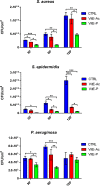In vitro comparison between α-tocopheryl acetate and α-tocopheryl phosphate against bacteria responsible of prosthetic and joint infections
- PMID: 28759643
- PMCID: PMC5536291
- DOI: 10.1371/journal.pone.0182323
In vitro comparison between α-tocopheryl acetate and α-tocopheryl phosphate against bacteria responsible of prosthetic and joint infections
Abstract
Biofilm-related infections represent a recurrent problem in the orthopaedic setting. In recent years, great interest was directed towards the identification of novel molecules capable to interfere with pathogens adhesion and biofilm formation on implant surfaces. In this study, two stable forms of α-tocopherol, the hydrophobic acetate ester and the water-soluble phosphate ester, were tested in vitro as coating for titanium prosthesis. Antimicrobial activity against microorganisms responsible of prosthetic and joints infections was assessed by broth microdilution method. In addition, α-tocopherol esters were evaluated for both their ability to hamper bacterial adhesion to and biofilm formation on sandblasted titanium surfaces. Results showed that only α-tocopheryl phosphate displayed antimicrobial activity against the tested strains. Both esters were able to significantly interfere with bacterial adhesion and to prevent biofilm formation, especially by Staphylococcus aureus and Staphylococcus epidermidis. The activity of α-tocopheryl phosphate was greater than that of α-tocopheryl acetate. Alterations at membrane levels have been reported in literature and may be likely responsible for the interference on bacterial adhesion and biofilm formation shown by α-tocopherol esters. Although further studies are needed to better investigate the mechanisms of action and the spectrum of activity of α-tocopherol esters, these characteristics together with the positive effect on wound healing and immune response, make these molecules promising candidate for coating in order to prevent implant-associated infections.
Conflict of interest statement
Figures


References
-
- Brigelius-Flohé R, Traber MG. Vitamin E: function and metabolism. FASEB J. 1999; 13: 1145–1155. - PubMed
-
- Smith D, O’Leary VJ, Darley-Usmar VM. The role of alpha-tocopherol as a peroxyl radical scavenger in human low density lipoprotein. Biochem Pharmacol. 1993; 45: 2195–2201. - PubMed
-
- Hobson R. Vitamin E and wound healing: an evidence-based review. Int Wound J. 2016; 13: 331–335. doi: 10.1111/iwj.12295 - DOI - PMC - PubMed
-
- Zingg JM, Libinaki R, Lai CQ, Meydani M, Gianello R, Ogru E, et al. Modulation of gene expression by alpha-tocopherol, alpha-tocopheryl phosphate in THP-1 monocytes. FRBM. 2010; 49: 1989–2000. - PubMed
-
- Beijersbergen van Henegouwen GM, Junginger HE, de Vries H. Hydrolysis of RRR-alpha-tocopheryl acetate (vitamin E acetate) in the skin and its UV protecting activity (an in vivo study with the rat). J Photochem Photobiol B. 1995; 29: 45–51. - PubMed
Publication types
MeSH terms
Substances
LinkOut - more resources
Full Text Sources
Other Literature Sources
Medical

